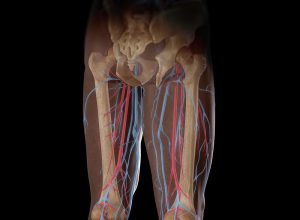Use of FVFG for Active Patients Ineligible for Total Hip Replacement

Two Duke hand specialists have established a growing surgical practice performing free vascularized fibular grafting (FVFG) to reverse vascular necrosis and preserve the hip in younger patients.
More than 75 cases are referred each year from across the United States to orthopaedic surgeons Marc J. Richard, MD, and David S. Ruch, MD. “We are now handling the vast majority of these procedures in this country,” Richard says, noting that Duke is the only medical center regularly performing the procedure.
During FVFG, a portion of the fibula, along with its blood supply, is removed and transplanted into the femoral head. Microvascular surgery and bone grafting are required. Because of their microvascular expertise as hand surgeons, Richard and Ruch bring specialized skills to FVFG.
For physically active patients 35 years of age or younger, FVFG offers a joint-sparing alternative to total hip replacement. Primary joint replacement is generally effective for 20 years. Surgeons are often required to replace or modify the joint, resulting in bone loss and reduced flexibility.
“FVFG is a solution for a set of indications with necrosis on the femoral head or ball side of the joint,” says Richard. “These patients are just too young and too active for an artificial hip. Other than this graft, they don’t have good options.”
Age, activity level, and overall health are the key factors in determining whether FVFG will be effective. “If the patient is going to be physically active for a long time, that patient will be much better off with his or her own hip structure than an artificial joint,” Richard says.
A large portion of the cases seen by Richard and Ruch are pediatric patients experiencing bone necrosis following childhood pathologies such as leukemia and malignancies or exposure to chemotherapy or high-dose prednisone.
Because of the success and frequency of total hip replacement, the fibular graft is still a relatively rare procedure. “We are clearly working with a niche patient base,” Richard says. “We don’t see a huge number of cases, but it’s very effective for a specific profile of age and activity.” Richard adds that the number of cases is gradually increasing.